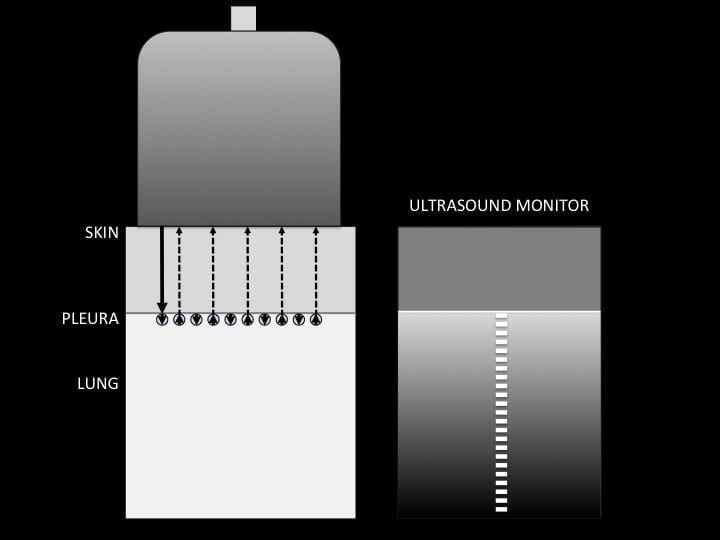Short path reverberation artefact
**B-lines = Short path reverberation artefact
Reverberation Artefact Refresh
An ultrasound machine assumes a single pulse of ultrasound enters the tissues, is reflected off a structure, and returns directly to the transducer for interpretation. When this does not occur ultrasound artefacts are created.
Not infrequently an ultrasound pulse encounters two parallel reflective surfaces lying perpendicular to its path. Some of the pulse becomes caught between the two surfaces, bouncing forwards and backwards before returning in increments, between each reverberation, to the transducer. This reverberation causes a repetitive artefact on the ultrasound image.
The appearance of the reverberation artefact depends on:
- The size of the two reflective surfaces
- The distance between the two reflective surfaces (long vs short path reverberation artefacts)
- How much ultrasound energy is lost – dissipated or attenuated, between each re-reflection.
Short path reverberation artefact
The ultrasound appearance of this artefact is a thin vertical bright or echogenic line that passes from the point of origin, to the deepest part of the ultrasound image.
Most commonly this artefact originates as an ultrasound pulse reverberates within a tiny soft tissue or fluid filled collection, that is surrounded by air. In the case of lung immediately sub-pleural interstitial fluid, fibrosis or alveolar fluid is the typical origin.
- When appearing deep to the pleural line these are known as B-lines.
- Elsewhere in the body the identical artefact is known as ring down artefact.
- Where these artefacts fade quickly they are called comet tail artefacts
Short path reverberation artefact (B-lines or ring-down)
The image shows how a B-line is formed. A pulse of ultrasound gets trapped between two very small, close reflective surfaces such as a fluid filled alveolus, or a tiny area of interstitial fibrosis. Where the reflective surfaces are less than half an ultrasound pulse length apart, a true continuous short path reverberation artefact is created.

The ultrasound pulse reverberating back and forth, and with each return a small amount of the pulse is sent back to the transducer. In this example the pulses are sent back in separate segments, but in true short path reverberation artefact a continuous pulse is returned to the transducer and a continuous echogenic stripe is cast on the ultrasound image.
Each returning reverberation remains strong because the beam is completely reflected off a perpendicular surface, and there is very little attenuation within the fluid filled sphere. Time gain compensation (TGC) also compensates for any slight loss in ultrasound energy that may occur with each reverberation.
An example of B-lines
The ultrasound clip above is a case of pulmonary oedema. The multiple bright, moving, echogenic lines that start at the pulmonary surface and extend to the extreme depths of the ultrasound image are created by short path reverberation artefact. It is occurring within fluid filled alveoli that are moving with each respiratory cycle. When in the chest these are called B-lines.
Example of ring down artefact
Short path reverberation artefacts occurring where gas and liquid interact in the duodenum. The multiple bright, moving, echogenic lines that start just deep to the bowel wall extend to the depths of the ultrasound image and are typical of this artefact. This is also known as ring down artefact.
Short path reverberation artefacts explained
Further Reading
- Long path reverberation artefact (A-lines in lung)
- Short path reverberation artefact (B-lines in lung; ringdown anywhere else!)
- Fatiguing short path reverberation artefact (Comet tails)
ULTRASOUND LIBRARY
Basics
An Emergency physician based in Perth, Western Australia. Professionally my passion lies in integrating advanced diagnostic and procedural ultrasound into clinical assessment and management of the undifferentiated patient. Sharing hard fought knowledge with innovative educational techniques to ensure knowledge translation and dissemination is my goal. Family, wild coastlines, native forests, and tinkering in the shed fills the rest of my contented time. | SonoCPD | Ultrasound library | Top 100 | @thesonocave |

